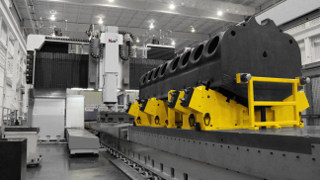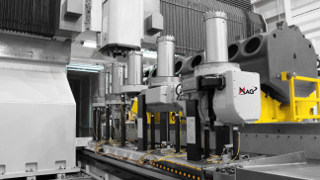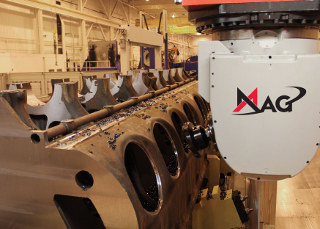 |
| September 04, 2012 | Volume 08 Issue 33 |
Mechanical News & Products
Designfax weekly eMagazine
Archives
Partners
Manufacturing Center
Product Spotlight
Modern Applications News
Metalworking Ideas For
Today's Job Shops
Tooling and Production
Strategies for large
metalworking plants
Engineer's Toolbox: How to design the optimum hinge
 Although many pin styles are available, Coiled Spring Pins are particularly well suited for
use in both friction- and free-fit hinges. To achieve optimum long-term hinge performance,
designers should observe these helpful design guidelines from SPIROL.
Although many pin styles are available, Coiled Spring Pins are particularly well suited for
use in both friction- and free-fit hinges. To achieve optimum long-term hinge performance,
designers should observe these helpful design guidelines from SPIROL.
Read the full article.
Innovative new robo welding gun
 Comau's newest N-WG welding gun is designed for high-speed spot welding for traditional, hybrid, and electric vehicles, in addition to general industry sectors. It features a patented, single-body architecture that enables rapid reconfiguration between welding types and forces, and it delivers consistent performance across a broad range of applications, including steel and (soon) aluminum welding. It supports both X and C standard gun configurations, has fast arm exchange, and universal mounting options. It is fully compatible with major robot brands and represents a significant advancement in spot welding performance and cost efficiency.
Comau's newest N-WG welding gun is designed for high-speed spot welding for traditional, hybrid, and electric vehicles, in addition to general industry sectors. It features a patented, single-body architecture that enables rapid reconfiguration between welding types and forces, and it delivers consistent performance across a broad range of applications, including steel and (soon) aluminum welding. It supports both X and C standard gun configurations, has fast arm exchange, and universal mounting options. It is fully compatible with major robot brands and represents a significant advancement in spot welding performance and cost efficiency.
Learn more.
What's a SLIC Pin®? Pin and cotter all in one!
 The SLIC Pin (Self-Locking Implanted Cotter Pin) from Pivot Point is a pin and cotter all in one. This one-piece locking clevis pin is cost saving, fast, and secure. It functions as a quick locking pin wherever you need a fast-lock function. It features a spring-loaded plunger that functions as an easy insertion ramp. This revolutionary fastening pin is very popular and used successfully in a wide range of applications.
The SLIC Pin (Self-Locking Implanted Cotter Pin) from Pivot Point is a pin and cotter all in one. This one-piece locking clevis pin is cost saving, fast, and secure. It functions as a quick locking pin wherever you need a fast-lock function. It features a spring-loaded plunger that functions as an easy insertion ramp. This revolutionary fastening pin is very popular and used successfully in a wide range of applications.
Learn more.
Engineering challenge: Which 3D-printed parts will fade?
 How does prolonged exposure to intense UV light impact 3D-printed plastics? Will they fade? This is what Xometry's Director of Application Engineering, Greg Paulsen, set to find out. In this video, Paulsen performs comprehensive tests on samples manufactured using various additive processes, including FDM, SLS, SLA, PolyJet, DLS, and LSPc, to determine their UV resistance. Very informative. Some results may surprise you.
How does prolonged exposure to intense UV light impact 3D-printed plastics? Will they fade? This is what Xometry's Director of Application Engineering, Greg Paulsen, set to find out. In this video, Paulsen performs comprehensive tests on samples manufactured using various additive processes, including FDM, SLS, SLA, PolyJet, DLS, and LSPc, to determine their UV resistance. Very informative. Some results may surprise you.
View the video.
Copper filament for 3D printing
 Virtual Foundry, the company that brought us 3D-printable lunar regolith simulant, says its popular Copper Filamet™ (not a typo) is "back in stock and ready for your next project." This material is compatible with any open-architecture FDM/FFF 3D printer. After sintering, final parts are 100% pure copper. Also available as pellets. The company says this is one of the easiest materials to print and sinter. New Porcelain Filamet™ available too.
Virtual Foundry, the company that brought us 3D-printable lunar regolith simulant, says its popular Copper Filamet™ (not a typo) is "back in stock and ready for your next project." This material is compatible with any open-architecture FDM/FFF 3D printer. After sintering, final parts are 100% pure copper. Also available as pellets. The company says this is one of the easiest materials to print and sinter. New Porcelain Filamet™ available too.
Learn more and get all the specs.
Copper foam -- so many advantages
 Copper foam from Goodfellow combines the outstanding thermal conductivity of copper with the structural benefits of a metal foam. These features are of particular interest to design engineers working in the fields of medical products and devices, defense systems and manned flight, power generation, and the manufacture of semiconductor devices. This product has a true skeletal structure with no voids, inclusions, or entrapments. A perennial favorite of Designfax readers.
Copper foam from Goodfellow combines the outstanding thermal conductivity of copper with the structural benefits of a metal foam. These features are of particular interest to design engineers working in the fields of medical products and devices, defense systems and manned flight, power generation, and the manufacture of semiconductor devices. This product has a true skeletal structure with no voids, inclusions, or entrapments. A perennial favorite of Designfax readers.
Learn more.
Full-color 3D-printing Design Guide from Xometry
 With Xometry's PolyJet 3D-printing service, you can order full-color 3D prints easily. Their no-cost design guide will help you learn about different aspects of 3D printing colorful parts, how to create and add color to your models, and best practices to keep in mind when printing in full color. Learn how to take full advantage of the 600,000 unique colors available in this flexible additive process.
With Xometry's PolyJet 3D-printing service, you can order full-color 3D prints easily. Their no-cost design guide will help you learn about different aspects of 3D printing colorful parts, how to create and add color to your models, and best practices to keep in mind when printing in full color. Learn how to take full advantage of the 600,000 unique colors available in this flexible additive process.
Get the Xometry guide.
Tech Tip: How to create high-quality STL files for 3D prints
 Have you ever 3D printed a part that had flat spots or faceted surfaces where smooth curves were supposed to be? You are not alone, and it's not your 3D printer's fault. According to Markforged, the culprit is likely a lack of resolution in the STL file used to create the part.
Have you ever 3D printed a part that had flat spots or faceted surfaces where smooth curves were supposed to be? You are not alone, and it's not your 3D printer's fault. According to Markforged, the culprit is likely a lack of resolution in the STL file used to create the part.
Read this detailed and informative Markforged blog.
Test your knowledge: High-temp adhesives
 Put your knowledge to the test by trying to answer these key questions on how to choose the right high-temperature-resistant adhesive. The technical experts from Master Bond cover critical information necessary for the selection process, including questions on glass transition temperature and service temperature range. Some of the answers may surprise even the savviest of engineers.
Put your knowledge to the test by trying to answer these key questions on how to choose the right high-temperature-resistant adhesive. The technical experts from Master Bond cover critical information necessary for the selection process, including questions on glass transition temperature and service temperature range. Some of the answers may surprise even the savviest of engineers.
Take the quiz.
Engineer's Toolbox: How to pin a shaft and hub assembly properly
 One of the primary benefits of using a coiled spring pin to affix a hub or gear to a shaft is the coiled pin's ability to prevent hole damage. Another is the coiled pin absorbs wider hole tolerances than any other press-fit pin. This translates to lower total manufacturing costs of the assembly. However, there are a few design guidelines that must be adhered to in order to achieve the maximum strength of the pinned system and prevent damage to the assembly.
One of the primary benefits of using a coiled spring pin to affix a hub or gear to a shaft is the coiled pin's ability to prevent hole damage. Another is the coiled pin absorbs wider hole tolerances than any other press-fit pin. This translates to lower total manufacturing costs of the assembly. However, there are a few design guidelines that must be adhered to in order to achieve the maximum strength of the pinned system and prevent damage to the assembly.
Read this very informative SPIROL article.
What's new in Creo Parametric 11.0?
 Creo Parametric 11.0 is packed with productivity-enhancing updates, and sometimes the smallest changes make the biggest impact in your daily workflows. Mark Potrzebowski, Technical Training Engineer, Rand 3D, runs through the newest functionality -- from improved surface modeling tools to smarter file management and model tree navigation. Videos provide extra instruction.
Creo Parametric 11.0 is packed with productivity-enhancing updates, and sometimes the smallest changes make the biggest impact in your daily workflows. Mark Potrzebowski, Technical Training Engineer, Rand 3D, runs through the newest functionality -- from improved surface modeling tools to smarter file management and model tree navigation. Videos provide extra instruction.
Read the full article.
What's so special about wave springs?
 Don't settle for ordinary springs. Opt for Rotor Clip wave springs. A wave spring is a type of flat wire compression spring characterized by its unique waveform-like structure. Unlike traditional coil springs, wave springs offer an innovative solution to complex engineering challenges, producing forces from bending, not torsion. Their standout feature lies in their ability to compress and expand efficiently while occupying up to 50% less axial space than traditional compression springs. Experience the difference Rotor Clip wave springs can make in your applications today!
Don't settle for ordinary springs. Opt for Rotor Clip wave springs. A wave spring is a type of flat wire compression spring characterized by its unique waveform-like structure. Unlike traditional coil springs, wave springs offer an innovative solution to complex engineering challenges, producing forces from bending, not torsion. Their standout feature lies in their ability to compress and expand efficiently while occupying up to 50% less axial space than traditional compression springs. Experience the difference Rotor Clip wave springs can make in your applications today!
View the video.
New Standard Parts Handbook from JW Winco
 JW Winco's printed Standard Parts Handbook is a comprehensive 2,184-page reference that supports designers and engineers with the largest selection of standard parts categorized into three main groups: operating, clamping, and machine parts. More than 75,000 standard parts can be found in this valuable resource, including toggle clamps, shaft collars, concealed multiple-joint hinges, and hygienically designed components.
JW Winco's printed Standard Parts Handbook is a comprehensive 2,184-page reference that supports designers and engineers with the largest selection of standard parts categorized into three main groups: operating, clamping, and machine parts. More than 75,000 standard parts can be found in this valuable resource, including toggle clamps, shaft collars, concealed multiple-joint hinges, and hygienically designed components.
Get your Standard Parts Handbook today.
Looking to save space in your designs?
 Watch Smalley's quick explainer video to see how engineer Frank improved his product designs by switching from traditional coil springs to compact, efficient wave springs. Tasked with making his products smaller while keeping costs down, Frank found wave springs were the perfect solution.
Watch Smalley's quick explainer video to see how engineer Frank improved his product designs by switching from traditional coil springs to compact, efficient wave springs. Tasked with making his products smaller while keeping costs down, Frank found wave springs were the perfect solution.
View the video.
Top die casting design tips
 You can improve the design and cost of your die cast parts with these top tips from Xometry's Joel Schadegg. Topics include: Fillets and Radii, Wall Thicknesses, Ribs and Metal Savers, Holes and Windows, Parting Lines, and more. Follow these recommendations so you have the highest chance of success with your project.
You can improve the design and cost of your die cast parts with these top tips from Xometry's Joel Schadegg. Topics include: Fillets and Radii, Wall Thicknesses, Ribs and Metal Savers, Holes and Windows, Parting Lines, and more. Follow these recommendations so you have the highest chance of success with your project.
Read the full Xometry article.
170 tons: MAG completes mammoth portal mill built to produce large diesel engines and massive industrial components
One of MAG's newest product developments, the giant 6-axis U6 bridge-type portal mill, is completing its runoff in Hebron, KY, prior to shipping later this year. The massive machine, which weighs nearly 154 MT (170 tons), is outfitted with five interchangeable cutting heads, including two custom designs to allow five-sided machining on oversized diesel engine blocks and industrial components. Equipped to deliver up to 74.5 kW (100 hp) into the cut, the machine can complete all six sides of a 5,900-kg (13,000-lb), 16- or 20-cylinder diesel engine block in just three setups at a total time of about 30 hr. The turnkey solution from MAG includes the machine, special spindle heads, cutting tools, part programs, and workholding fixture.

The U6 is engineered for heavy-duty machining of large precision parts, such as this 16-cylinder diesel engine block weighing 5,900 kg (13,000 lb). The machine's robust construction makes it ideal for heavy cuts in steel, titanium, Inconel, or cast iron.

The U6's full complement of accessories includes a spindle head storage/retrieval system that allows automatic head changes to maximize the machine's productivity. The special-purpose heads enable completion of a multitude of complex features on five sides of the part in one setup.
This particular machine has a working range of 13 m x 2.6 m x 1 m x 1.25 m (X-Y-W-Z), with speeds up to 20 m/min (787 ipm) and linear-axis repeatability of 0.01 mm (0.0004 in.). The W+Z axes combined deliver a programmable vertical range of 2.25 m (7.3 ft) for deep reach into or around parts. The machine is configured with a two-table system to transfer workpieces in and out of the cutting zone, enabling it to cut one part while a second is being set up or unloaded off line. This allows parts to be machined in sets of two, using the five spindle heads and a full complement of operations including milling, facing, boring, drilling, tapping, and specialty serration milling. The five spindle heads are changed automatically for maximum efficiency and minimal cycle time.
"This machine is the newest and most advanced design in its class, utilizing linear way technology and all-electric drives for speed, accuracy, and energy efficiency," says Chip Storie, MAG executive vice president. "It is whisper quiet, and proved its dynamic stiffness during sustained-power qualification tests. It will produce the customer's parts in less time, at a lower cost, when all the high-efficiency features are applied, giving the customer a competitive advantage."
Engineered for lean machining of large parts
The U6 universal machining center is engineered for lean manufacturing of large complex-geometry parts. Its 5-axis machining and contouring capabilities minimize downtime, part reorientations, and set ups. The machine's robust construction makes it ideal for heavy cuts in large cast iron, steel, Inconel, or titanium parts encountered in aerospace, off-road, energy, marine, and mining equipment. The U6's energy-efficient all-electric design eliminates hydraulic noise and maintenance issues, particularly compared to older-style, hydrostatic guideways. Replaceable low-friction linear guideways improve axis responsiveness and help reduce energy consumption.

The U6 can be outfitted with a range of high-torque or high-speed spindles, up to 74.5 kW (100 hp) and 24,000 rpm, with choice of tapers, and vertical, horizontal, 5-axis, or custom head configurations to cover a wide spectrum of machining requirements. This photo shows the contouring gimbal head machining the ports on the diesel engine block.
Available in a bridge or traveling gantry design, the U6 can be configured with a crossrail (Y-axis) up to 9 m (29.5 ft), while the adjustable W-axis (vertical crossrail movement) provides up to 5 m (16.4 ft) additional travel to complement up to 2.5 m (8.2 ft) of Z-axis range. The maximum 7.5-m (24.6-ft) programmable vertical range of the machine (W+Z axes) gives it the capacity to machine, or maneuver over, tall or oddly shaped workpieces. The design allows the Y-axis rail to be positioned close to the part for machining with minimal Z-axis extension and maximum stiffness for tight accuracy. As options, the U6 is offered with a choice of 1-m, 1.5-m, 2-m, or 2.5-m Z-axis ram travel for best fit to processing needs.
The U6B bridge-type machine can be equipped with an optional X-axis pallet shuttle system for cellular processing with single or multiple machines. It is available with a broad range of table and pallet shuttle systems. The U6R rail-type traveling gantry design offers unlimited X-axis travel, and is expandable to fit the application.
The U6 can be outfitted with a range of high-torque or high-speed spindles, up to 74.5 kW (100 hp) and up to 24,000 rpm, choice of tapers, and vertical, horizontal, or 5-axis head configurations to cover the spectrum of machining requirements. Automatic head exchanges are programmable, fully automated, and accomplished in about 1 min. The C-axis option is built into the Z-axis ram and is offered 360-degree continuous rotation to keep the spindle in-cut without running out of C-axis travel or waiting for unwind. Custom head configurations are also available.
Source: MAG
Published September 2012
Rate this article
View our terms of use and privacy policy


